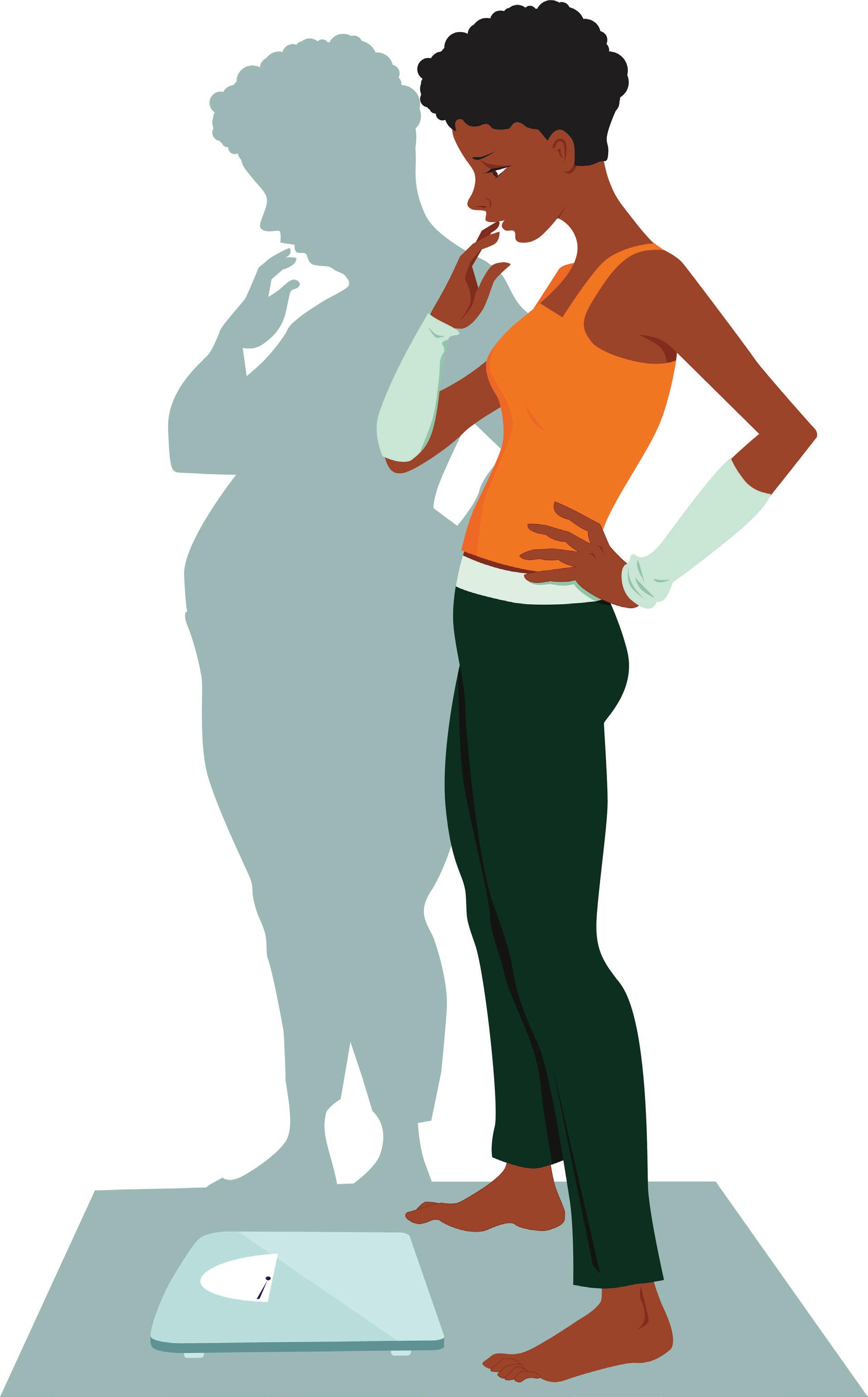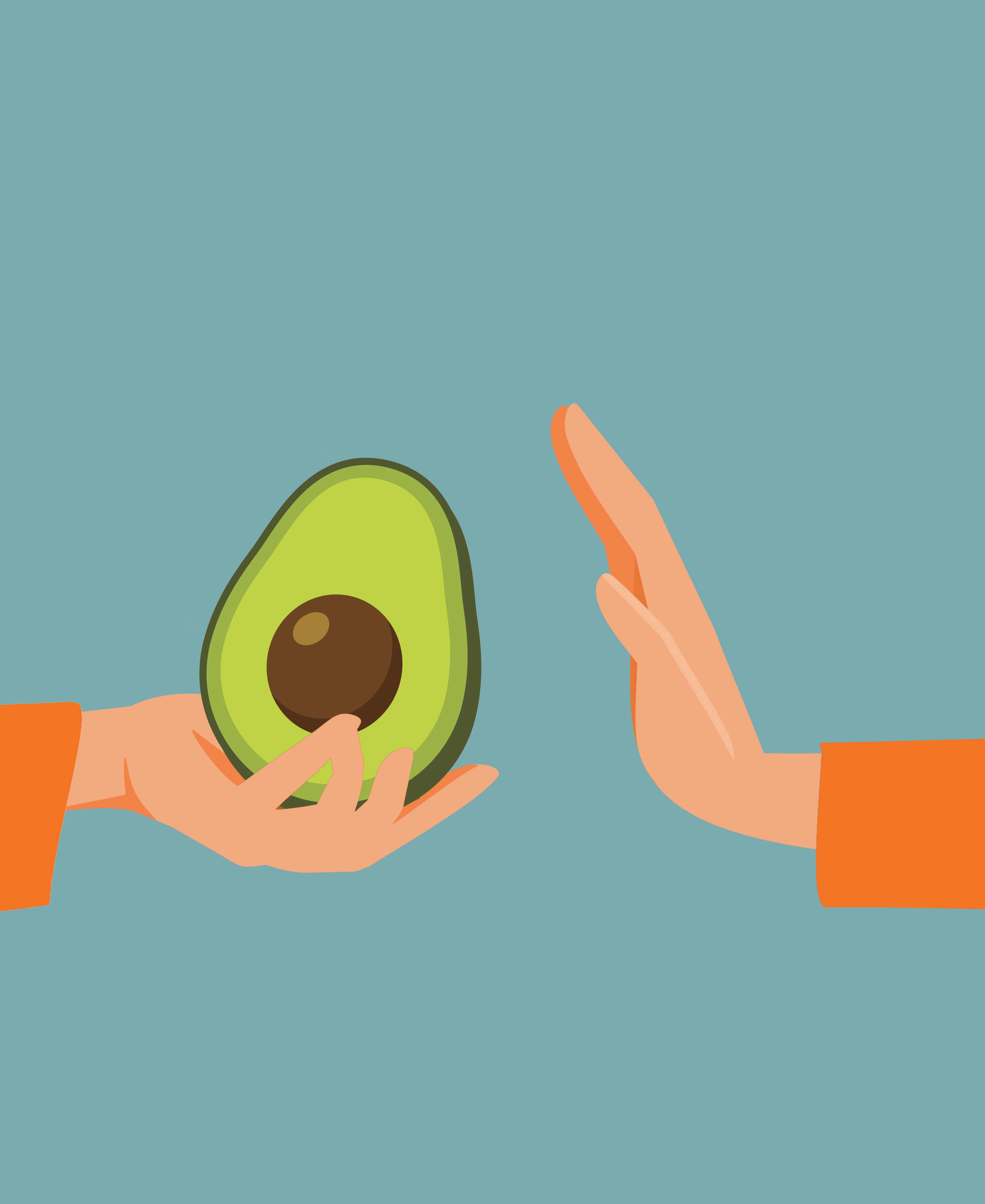
9 minute read
Hungry For Perfection
Eating disorders were on the rise—then the pandemic made the problem worse. But therapy and family support can help. By Leslie Garisto Pfaff
It was January 2021, almost a year into the pandemic, when Nora Green first noticed the change in her daughter Sarah. (Both names are aliases to protect their identities.) Gone was the effervescent 12-year-old, replaced by a moody preteen who looked haggard and drawn. Then her older sister discovered a log Sarah had been keeping, in which she noted everything she ate along with its calorie count, as well as total calories for the day. In a matter of months, those totals had plummeted from 900 to 90.
“I was overwhelmed and lost,” her mother says. “I saw this bright, bubbly girl turn into a zombie in front of my eyes.”
Alarmed, Green took her daughter to an adolescent specialist at Hackensack University Medical Center, who diagnosed Sarah with anorexia, the eating disorder characterized by severe food self-restriction, and referred the family to Gila Cohen Davidovsky, a Teaneck-based therapist who specializes in eating disorders. Even as Sarah fought to overcome the disorder, she evidenced many of the typical effects of anorexia: Her hair was falling out; her menstrual cycle was irregular; and twice she had to be rushed to the ER with chest pains.
THE COVID CONNECTION
In Bergen County and elsewhere, eating disorders rose dramatically during the pandemic. Calls to the National Eating Disorders Association helpline increased by 40 percent, and in a study published in the International Journal of Eating Disorders, some 70 percent of patients surveyed reported that their concerns about eating and weight had also increased during the pandemic. Adrienne Mariano, senior director of Behavioral Health Services at the Center for Eating Disorders and Body Positivity at Bergen New Bridge Medical Center, attributes that rise, in part, to pandemic isolation.
“We didn’t have our support systems readily available; things that we normally use as coping mechanisms, like traveling or going to the gym, were suddenly taken away; we were sitting for hours in front of a computer and not exercising; many of us were bingeing on comfort foods; and we were getting bombarded with negative messages on social media about how our bodies should look,” she says. As it happens, Sarah Green was inspired to keep her calorie log by an onslaught of TikTok videos in which impossibly thin young women recommended the technique as a way to keep oneself on the straight and narrow.
The Center for Eating Disorders was founded in November 2022 as a response to the burgeoning numbers of county and state residents suffering from anorexia, bulimia— characterized by bingeing and purging—and other forms of disordered eating. The center estimates that some 375,000 New Jersey residents currently have an eating disorder and nearly a million more will suffer from one at some point.
“Eating disorders are one of the deadliest mental illnesses, second only to opioid addiction,” Mariano says. “We have so much awareness of and so many programs addressing the opioid epidemic, but we’re not talking about eating disorders.” In the U.S. alone, she says, someone dies as a direct result of an eating disorder every 52 minutes.
WHO’S AT RISK?
While the term “eating disorder” conjures images of rail-thin young women, there really is no typical patient. “I see more clients who are in a healthy weight range, but they’re still exhibiting disordered eating and it still can be just as life-threatening,” says Lisa Shohen, a Midland Park therapist who specializes in treating eating disorders. A study out of Stanford University School of Medicine compared patients with typical and atypical anorexia (the latter defined as anorexia in those of normal weight). People in both groups evidenced severely restricted eating habits. Although the atypical patients were still in the normal weight range at the end of a year, they exhibited the same potentially deadly symptoms as
—Adrienne Mariano, senior director, Behavioral Health Services at the Center for Eating Disorders and Body Positivity, Bergen New Bridge Medical Center

those in the typical group, including slow Although the majority of Shohen’s patients are female, she’s seeing a growing number of boys and men. In fact, one in four sufferers are male, and they have a greater chance of dying from an eating disorder because they tend to be diagnosed later in the course of the disease.
According to the nonprofit National Eating Disorders Association, more than one-third of male athletes in sports that emphasize appearance—including wrestling, rowing, bodybuilding, gymnastics and swimming—suffer from disordered eating. (The comparable proportion is 62 percent in women athletes in similar so-called weight and aesthetic sports.) And whatever their gender, members of the LGBTQ+ community are at greater risk for eating disorders—most likely, experts suggest, as a result of the unique stresses they experience, especially in adolescence.
Of course, there’s some truth to the stereotype: Eating disorders are most prevalent among girls and young women between the ages of 12 and 25. Jessica Kashammer, a 39-year-old resident of Hillsdale, is in treatment for what she describes as “a disordered and incredibly unhealthy relationship with food, body and weight that manifests itself in an extreme version of yo-yo dieting,” which began when she was nine. She explains that she was predisposed toward the disorder by her sensitivity and perfectionism. Dieting, she says, “was the most immediate, easiest thing for my brain to use to cope with life.”
In fact, perfectionism is one aspect of what Shohen calls the eating disorders personality type, especially among those with anorexia. “They’re also obedient rule-followers,” she says, “and they tend to suppress their emotions. They may have low self-esteem or lack a sense of identity.” Those who suffer from bulimia, on the other hand, tend to be more volatile and impulsive.
There can be a predisposition to develop an eating disorder among people with mental or emotional difficulties—including depression, anxiety, obsessive-compulsive disorder (OCD), post-traumatic stress disorder (PTSD), substance abuse and attention-deficit hyperactivity disorder (ADHD). Add to any one of these maladies the stress of the pandemic and the chance of feeling out of control increases exponentially. And when you feel that you have little control over your life, one thing you can control—or so the disordered thinking goes—is what you do or don’t eat.
Tova, a 36-year-old resident of Englewood who asked that we withhold her last name, grew up in a highly religious family that disapproved of her outspokenness. At 15, the stress of her home situation, coupled with the normal stresses of burgeoning adolescence, played into the development of anorexia. “I landed on dieting as a way to have some control over my life,” she says, “because so many elements felt out of my control. And then it got worse from there.” When her diet started to yield visible results and compliments, she says, “it made me feel like I was doing something right, and it was a very heady feeling.”
A CULTURE OF BODY-SHAMING
One condition shared by virtually everyone who suffers from an eating disorder is the culture we live in, with its stress on looking, getting and staying thin. While there’s been a recent trend to celebrate people with larger body types, Shohen notes that we have years and years of negative messaging about weight to overcome, and those messages are still coming at us fast and furiously, exacerbated by social media and apps that can make you look thinner and fitter online. (Want an instant six-pack? There’s an app for that.) “You can scroll through Instagram and see hundreds of images and messages offering a very narrow definition of what beauty is,” Shohen says.
A DEADLY DISORDER
Every year in America, nearly 7,000 people die as the result of an eating disorder. Starvation, bingeing and purging and extreme dieting all take a massive toll on the body. Restricting calories (and the nutrients that go with them) can result in the loss of muscle mass. (After the body burns all of its fat stores, it turns to the muscles for energy.) “And,” says Mariano, “the largest muscle in the body is the heart, so an eating disorder can lead to an irregular heartbeat and other cardiac issues, including stroke.”
Malnutrition can also precipitate a drop in estrogen and a concurrent loss of menstruation, as well as osteoporosis and a deadly imbalance of electrolytes. And when you lose fat, you don’t just lose it in the obvious places: Neurons in the brain can be stripped of the fat that allows them to function, potentially leading to seizures. Because of her anorexia, Tova stopped getting her periods, and poor circulation kept her fingers blue no matter what the temperature. Like many people with anorexia, she started to grow extra body hair, her body’s attempt to keep her warm.
GETTING BETTER
If you or someone you love suffers from an eating disorder, the only way to treat it is through professional therapy. One of the most important things that Nora Green learned during her daughter’s treatment for anorexia was that, as much as she wanted to “fix it,” she couldn’t. “But I was very lucky to find a therapist and a nutritionist who clicked with my daughter, and she’s in such a better place now,” she says.
Cohen Davidovsky agrees that professional help is needed. Because of the inherent complexity of eating disorders, with their multifarious causes and the involvement of both mind and body, “working for the best course of action isn’t something a parent can navigate without assistance,” she says. A therapist can help decide between inpatient and outpatient treatment, the latter often a necessity for patients whose vital signs have been severely compromised by an eating disorder. For these patients, “refeeding”—gradually upping their intake of calories—requires expert medical supervision. Mariano notes that overfeeding a patient can sometimes be lethal.
For all patients, nutritional therapy must be coupled with behavioral therapy, which seeks to identify and change unhealthy behaviors; dialectical behavioral therapy (DBT), which focuses on teaching core skills for healthier living; or other forms of psychotherapy. Family members are often included in therapy, as the family situation can both feed into the problem and, once treatment has begun, help the patient overcome it. “While it’s not right for everyone,” says Cohen Davidovsky, “familybased treatment can be very effective.”
For Tova, as for many patients, therapy has been a long-term proposition. Eating disorders are notoriously stubborn, and relapses are common. But Tova finally believes that her agony is behind her. “I remember thinking, as a teenager, that there was no hope,” she confesses. “But I’ve seen plenty of people recover, and I’ve recovered, and I know now that, outside of an eating disorder, there’s a very full and meaningful life to be had.”
HOW PARENTS CAN HELP WITH EATING DISORDERS
Children who grow up with a healthy attitude toward food and weight are far less likely to develop a disorder in the first place. To help foster that attitude, therapist Gila Cohen Davidovsky advises: • Don’t praise your child for dieting. • Model healthy eating habits—eat nutritious foods, allow hunger to dictate when and how much you eat, forgo extreme dieting. • Don’t comment on your own weight or the weight of others (including your child).
If you suspect an eating disorder, therapist Adrienne Mariano suggests: • Be aware of worrying signs, including withdrawal from social/ family life, eating less, running to the bathroom after a meal (to purge), drastic weight loss in a short period of time, swollen glands underneath the ears or jawline (a sign of purging), development of extremely fine body hair, fatigue, dizziness, irritability and problems with menstruation.









